Last Updated: 2 months ago
Most cat owners are used to seeing their furry feline friends bring up the occasional furball.
So that makes it all the more alarming when, instead, you see your cat throwing up white foam.
Why does this happen, and more importantly, how serious is it?
Keep reading for the vet-approved answer.
Why is my cat vomiting white foam?

There are many reasons why your cat could be vomiting white foam. Determining the reason requires insight into your cat’s behavior.
The frequency with which the vomiting occurs will also help inform you of potential causes.
#1 Accidentally ingesting toxins
It is important to note that it is not likely a cause for concern if it happens infrequently. House cats, and indeed cats in general, have a couple of unique adaptations to their digestive systems.
As such, a cat can expel toxins that they have accidentally ingested by bringing the toxins up in foamy vomit.
In this case, vomiting is a healthy bodily function. However, there is naturally a cause for concern if your cat is vomiting due to ingesting toxins too frequently.
#2 Over-eating
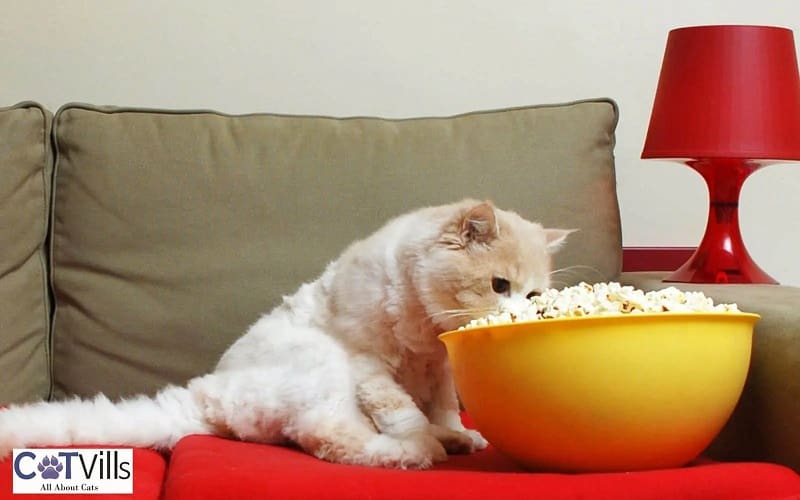
Just as we humans do, your cat may occasionally overindulge. But, once again, it is not a cause for concern if it is an isolated or infrequent occurrence.
Most mammals are likely to experience occasional vomiting.
Is my cat is obsessed with food? If they have overeaten, a cat will usually bring up the partially digested food. That said, It is not uncommon for the cat to bring up a white, foamy substance instead.
If your cat is overeating consistently, it may indicate a more serious underlying health issue. Therefore, it is best to consult a vet to determine the cause of the cat’s eating habits.
#3 Eating too quickly
As with overeating, a cat eating too quickly is not a reason for concern if it happens occasionally.
At some point, your cat is likely to dig in too eagerly and find itself vomiting up food or foam.
If it becomes a recurring problem, it may be because of the cat’s feeding routine. That is all the more likely if your cat follows an irregular routine. It is always best to keep feeding times regular and evenly spaced.
If multiple cats share the same food bowl or even the same feeding area, they are more likely to eat too quickly.
#4 Eating grass
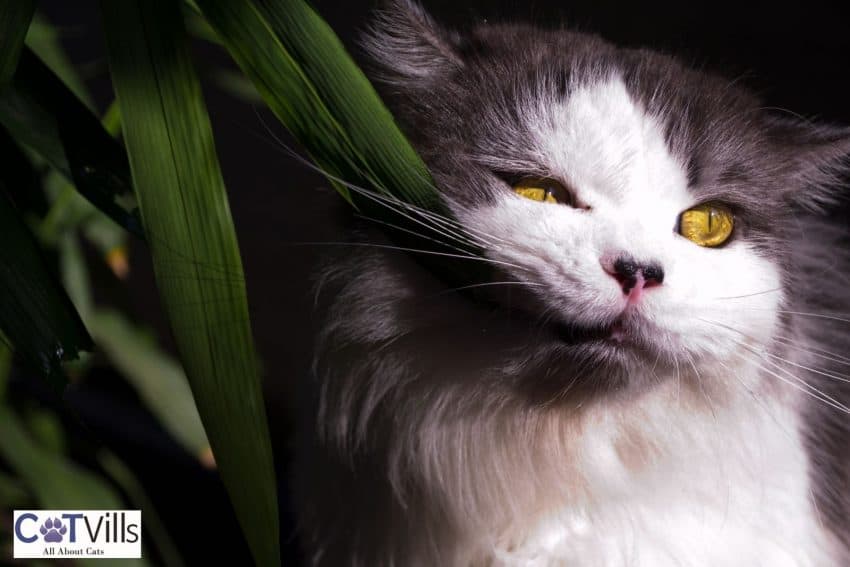
Cats cannot digest grass, even though they often eat it of their own accord. So, the behavior has led many veterinary professionals and cat behaviorists to believe that cats eat grass to induce vomiting.
We can’t be certain why cats do this, but many think that it may be due to the condition of the food that they catch.
Rats, mice, and birds might sometimes pose a serious health risk to the specialized feline digestive system.
Most adult cats are also lactose intolerant. It is because they lack the enzyme lactase, which is needed to break down lactose. It is, therefore, possible that they eat grass to expel lactose after drinking milk.
#5 Too active directly after a meal
Particularly prevalent in kittens and younger cats, your furry pal may jump straight back into play after eating. It isn’t as dangerous as some sources would have you believe, but it can certainly lead to vomiting.
If it becomes a frequent problem, consider separating kittens during feeding time. You can also keep cats enclosed in a room for 10-15 minutes after meals to help curb excessive play.
#6 Underlying ailments

Chronic vomiting is concerning. Several ailments can cause vomiting in cats. Frequently the vomiting will take the form of white or discolored foam.
Some conditions are relatively benign and easy to treat, such as constipation or food allergies. Others can be more serious and require medical intervention.
Internal parasites may require blood tests and medication. Inflammatory bowel disease may require medical treatment along with a change in diet.
Liver disease, a damaged stomach lining, and chronic kidney disease require life-long supportive care.
More serious reasons behind vomiting can include obstructions in the intestinal tract, gastroenteritis (Gastrointestinal diseases), or cancerous growths.
Only a vet can diagnose these conditions and recommend viable treatment options.
When Should I Be Concerned?
Here’s a good rule of thumb: if you’re asking yourself “should I be worried?” then call your vet. Follow your instincts!
That said, definitely call your vet if you notice any of these signs below.
#1 Behavioral changes

If the vomiting coincides with changes in your cat’s behavior, you should see a vet.
However, it may still be the case that your cat is just feeling a bit under the weather due to a bad meal or overeating.
However, noticeable changes in cats’ behavior are sometimes signs that something more serious is going on.
#2 Continuous, acute vomiting
While I must stress that it isn’t a guarantee that something serious is wrong, continuous vomiting warrants a visit to the vet. If the vomiting continues for more than twelve hours, you should consult your vet.
While it may not be symptomatic of a serious underlying ailment, continued vomiting can lead to dehydration, which in itself can become a serious health concern.
#3 Not eating
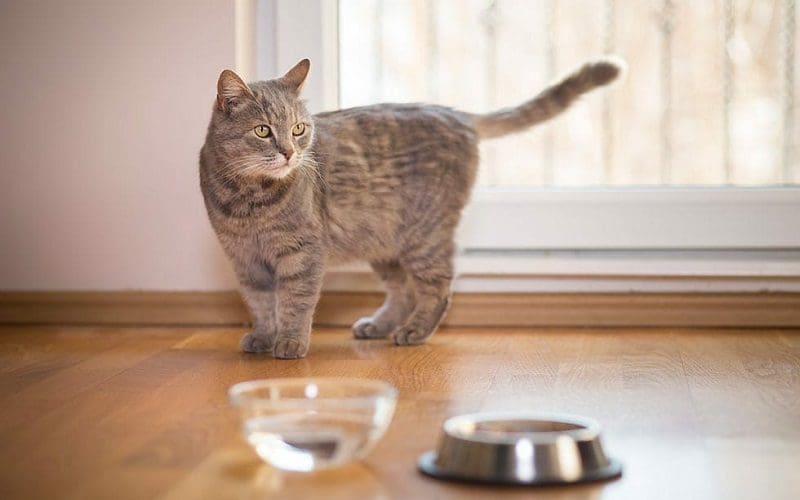
If the vomiting does not persist beyond twelve hours, your cat may still refuse food.
A lack of appetite after vomiting is common in cats. However, if they continue to refuse food for more than twenty-four hours, it is also reason enough to take them to the vet.
#4 Dry heaving
Dry heaving can indicate that the vomiting is not related to anything that the cat has recently ingested.
Severe nausea, which leads to dry heaving, is generally concerning and best addressed by a vet.
#5 Diarrhea and vomiting
While vomiting on its own can be harmless, vomiting and diarrhea combined might suggest one of a smaller number of more serious possibilities.
The combination is usually due to stomach inflammation caused by viral infections or food poisoning.
There is generally a good chance that the symptoms are the cause of an allergic reaction. The resulting condition on its own is not too much of a threat, but the potential rate of dehydration can be life-threatening.
#6 Discolored vomit
If the vomit is brown, it would indicate the presence of blood. Naturally, one would seek medical attention immediately if this is the case.
Green vomit indicates the presence of bile in the vomit, which can suggest an underlying condition equally as concerning—either of the above calls for an emergency visit to your vet.
Additional Hazards: Obstructions
Obstructions are one of the more common reasons cats vomit. Obstructions cause vomiting alongside other symptoms such as abdominal pain and loss of appetite.
When an obstruction is the cause of the vomiting, the vomit will have a mucus-like consistency.
Let us look at the primary causes of gastrointestinal obstructions in cats:
#1 Your cat’s fur
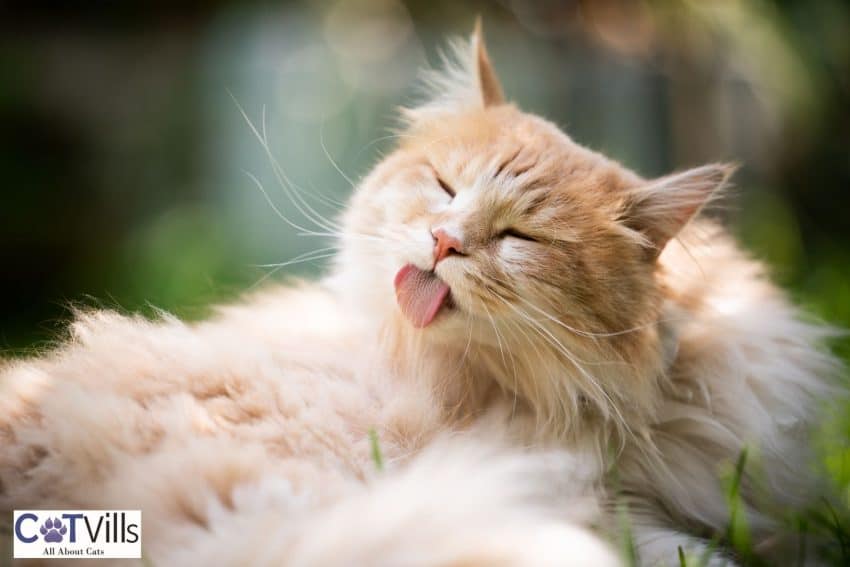
Cats tend to be nearly obsessive in their grooming. So, of course, they ingest their fur in the process.
Usually, they expel the ingested fur by coughing up furballs. However, sometimes the fur can pass into the digestive tract and create an obstruction.
#2 Indigestible fibers
Cats can ingest fibers that their body is not capable of digesting. The most common kinds are plant matter.
When this happens, it essentially has the same effect as unexpelled fur. The fibers create an obstruction which causes vomiting.
#3 Bones, feathers, and rodent pelts

While snacking on a catch, such as a bird or a rodent, a cat can accidentally ingest parts of the animal it can’t digest.
Undigested food can cause a blockage in the gastrointestinal tract and are usually more difficult to treat than other obstructions.
Wrap-Up
There are several reasons your cat might vomit white foam.
While some reasons are not a cause for concern, it is important to be vigilant and watch for signs that suggest that there may be a more serious underlying cause.
The general rule is that if in doubt, contact your vet.
Have you seen your cat throwing up white foam? What did you do? Let us know in the comments below!
Resources:
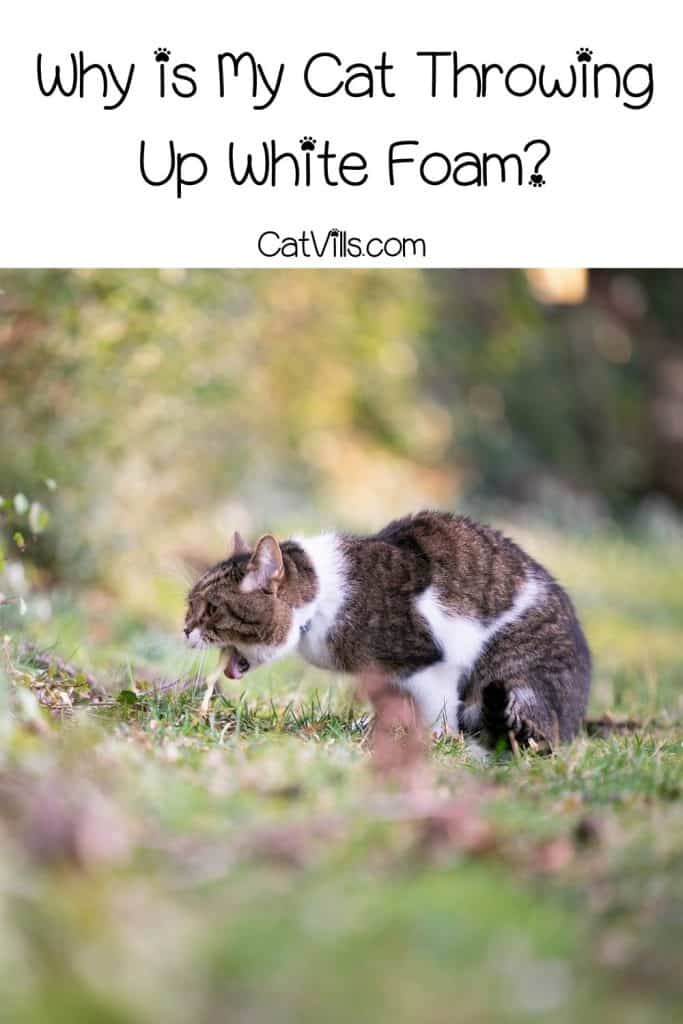

Dr. Linda Simon MVB MRCVS is a locum veterinary surgeon who has worked in London for the past 8 years. She graduated top of her class in small animal medicine from UCD, Dublin. She is currently a member of the Royal College of Veterinary Surgeons. Linda is the resident vet for Woman magazine and a frequent contributor to People’s Friend Magazine, the Dogzone website, Vet Help Direct and Wag! Linda also writes content for the CVS veterinary group, Vetwriter and a number of other establishments.
